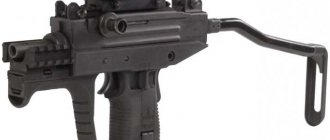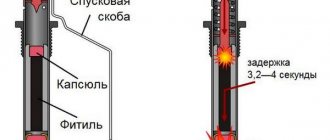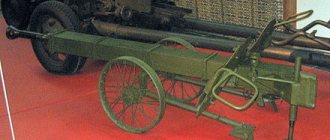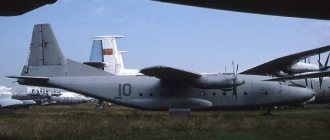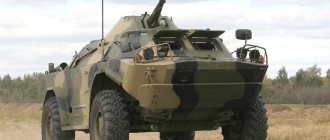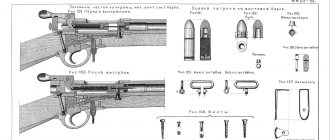Armored vehicle BA-64: creation
In the second half of the 1930s, the Red Army actively used armored vehicles of various types. During the Great Patriotic War, the combat capabilities of armored vehicles were significantly reduced due to relatively weak armor protection and weapons. The only armored vehicle that was adopted by the Red Army during the war was the BA-64. This light armored vehicle was created as a replacement for its predecessor, the BA-20.
The development of a new armored vehicle project began at the design bureau of the Gorky Automobile Plant in the late autumn of 1941, and on March 3, 1942, a prototype was already demonstrated in the Kremlin. The armored car was created on the basis of the GAZ-64 passenger car. The weight of the armored car exceeded 2.3 tons. The armored car was equipped with a 50 hp engine and a maximum highway speed of 80 km/h. The tires of the armored car are bulletproof. The crew consisted of two people - the commander and the driver. The body of the armored car is made of welded armor plates with a thickness of eight to thirteen millimeters. A 7.62 mm DT machine gun was installed in the octagonal turret.
BA-64 at the military equipment site. TsMVS, Moscow. (yablor.ru)
The ammunition consisted of 20 discs (1260 rounds). The high elevation angle made it possible to fire a machine gun not only at ground targets, but in some cases also at air targets. Due to difficult military conditions, the production plan for the BA-64 was constantly disrupted, and only in June 1942 did the new armored car begin to enter the active army in significant quantities. The BA-64 was supposed to be used as a reconnaissance and communications vehicle, intended to protect convoys on the march and strategically important objects.
Teenage Mutant Ninja Turtle
One of the main tactical disadvantages of wedges was the lack of a rotating turret, which did not allow them to quickly respond with fire to a suddenly appearing enemy and significantly reduced the range of fire. It is not surprising that at the turn of the twenties and thirties, A. Rozhkov, already known to us, on his own initiative, in his free time, took up the construction of a light armored car with a rotating machine-gun turret. By May 1932, after numerous engineering refinements, Rozhkov's Ford-A was finalized at the Izhora plant design bureau, where the idea was rethought. And the armored car, designated FAI (“Ford-A Izhora”), was actually designed anew. In February 1933, the first experimental armored car was assembled at the Izhora plant, and in 1934, the Vyksa crushing and grinding equipment plant mastered serial production of the FAI (DRO, Vyksa, Gorky region).
Since the architecture of the base chassis did not leave room for layout combinatorics, the FAI almost repeated the D-8 with the only difference being that in the rear of the flat roof of the armored hull there was a rotating turret equipped with a DT machine gun.
It was hardly possible to create something more capable on the low-power and clumsy Ford A (GAZ-A) chassis, but this did not make the FAI a truly successful car. On February 17, 1935, the head of the 1st Directorate of the UMM of the Red Army, Olshansky, sent a memo to the head of the UMM, I. Khalepsky, in which he pointed out the serious shortcomings of the FAI (“... this armored vehicle, being re-centered backwards (turret at the rear), showed negligible maneuverability when moving even on soft ground (softened clay, etc.). In these conditions, an armored vehicle can hardly take even the slightest incline and cannot move along the deep ruts of the road where the Ford-A car and the D-8 armored vehicle can easily pass...", demanded that the armored car be removed from production and the production of a light armored vehicle be launched, “... having a turret in the middle." However, the layout of the Ford A (GAZ-A) chassis did not allow the turret to be moved forward - along with it, the gunner located inside the armored hull would have to be moved, whose position in the FAI determined by the position of the driver's seat.Nevertheless, these armored vehicles were not only in service with the Red Army, but also managed to take part in hostilities in repelling Japanese aggression on the Khalkhin Gol River.
Armored car BA-64B: testing and operation
Tests and operation revealed a number of shortcomings of the armored car. The most significant was the overturning of the armored car when turning, which led to the creation of a new modification with a wider track. The armored car received a more powerful 54 hp engine. With. The new armored car received the designation BA-64B. At the end of May 1943, a decision was made to put the BA-64B into production and production of the modernized armored car was to begin in Gorky. But in June 1943, German aircraft subjected the Gorky Automobile Plant to a series of massive bombings, as a result of which the enterprise suffered serious damage.
BA-64 at the crossing of the Oder. (warbook.ru)
All this was reflected in the production of a new armored vehicle, the production of which was launched only in August 1943. Production of the BA-64 continued until 1946. A total of 3903 BA-64 and 5160 BA-64B were produced. Thus, the BA-64 and its modifications became the most popular Soviet armored vehicle and at the same time the last - in the future there was a transition to the creation of armored personnel carriers.
In addition to the mass-produced BA-64 and BA-64B, there were a number of experimental modifications. An attempt was made to strengthen the armament of the armored car by installing 12.7 mm instead of the DT-29. DShK heavy machine gun. But for this, the turret required major changes; in addition, the military was not satisfied with the small magazine capacity of 30 rounds, and the Gorky Automobile Plant refused to convert the armored vehicle into a belt-fed DShK, citing workload. As a result, the BA-64 with a heavy machine gun remained in a single copy.
Another option was an attempt in 1944 to rearm the armored car with a Goryunov machine gun, but due to the lack of a shoulder rest on this model, this idea was also not developed. An attempt was made to transform the BA-64 into an armored personnel carrier capable of transporting five soldiers. Some vehicles received improvised weapons in front-line conditions - there are examples of the BA-64 being equipped with an anti-tank rifle
Lost generation
By June 1939, an all-wheel drive platform based on the M-1 architecture and the M-11 engine was created. The 76-horsepower GAZ-11 engine was connected to a 4-speed GAZ-MM gearbox; torque was transmitted through an original single-stage transfer case. The rear axle was standard from M-1, the front axle was of an original design, with CV joints. The ground clearance in comparison with the Emka was more than doubled - to 320 cm. The first five all-wheel drive chassis were subjected to various tests, the results of which met all expectations. The cars demonstrated excellent maneuverability and endurance and at the same time were distinguished by good dynamics. The command of the Red Army had serious plans for the GAZ-61 platform, expecting to receive several modifications - a headquarters command vehicle with an Emka body, a cargo-passenger pickup truck that could be used with equal success by reconnaissance officers, border guards, signalmen and artillerymen, and, of course, a chassis designed for an armored hull. The beginning of the Great Patriotic War ruined all plans. Only 181 GAZ-61-73 staff vehicles with an Emka body and less than fifty GAZ-61-417 artillery tractors (in some documents these vehicles appear as GAZ-61-416) saw the light of day.
The latter hardly had the chance to prove themselves in intelligence. The enemy was rapidly advancing, without hiding, without digging in and without hiding its location. All-wheel drive pickup trucks had to serve in their artillery specialty - towing ZIS-2 guns and transporting artillery crews and ammunition. By the end of 1941, production of the GAZ-61 platform was discontinued. An armored car based on it was never created. And the point is not at all in the difficulties of wartime. It’s just that since the end of August 1941, the Gorky Automobile Plant mastered the production of a fundamentally new multi-purpose military all-wheel drive vehicle - the GAZ-64.
On the fronts of war: service and combat use of the BA-64
BA-64s were part of tank corps (31 units each), motorcycle regiments (10 units each) and reconnaissance battalions, which received 12 vehicles respectively. During combat operations, the BA-64 was actively used for reconnaissance and communications, and guarding convoys during movement. But there were exceptions.
Thus, in March 1945 in Hungary, the commander of the BA-64 Guard, Sergeant A. M. Starkov, burst into enemy positions and destroyed 7 enemy soldiers with a machine gun, ensuring a successful infantry attack and the capture of several dozen German soldiers. Although armored vehicles with light armor and machine gun armament were not often used to attack enemy positions, the losses of light armored vehicles were still very significant - more than half of the vehicles produced. Moreover, by the end of the war, the overwhelming majority of Soviet armored vehicles were BA-64s. Thus, in mid-May 1945, the Red Army had 3,314 armored vehicles, of which about 3 thousand were light BA-64s.
BA-64 at the Victory Parade on June 24, 1945. (bronetehnika.narod.ru)
In August 1945, BA-64s were also used during the Red Army's rapid campaign in the Far East against Japan. After the end of World War II, the BA-64 remained in service with the Soviet Army until the early 1950s. In addition to Soviet units, the BA-64 was in service with foreign formations formed on the territory of the Soviet Union. Thus, 10 armored vehicles were in Czechoslovak units, and 81 vehicles were transferred to the Polish Army. In the post-war period, BA-64s were used as police cars in the GDR. In the post-war period, BA-64s were supplied to China, Korea and a number of other countries. Quite a lot of BA-64s have survived to this day as museum exhibits.
M. Baryatinsky Armor Collection 2004 Special issue No. 02(06) Armored vehicles of the Red Army 1939—1945
Supplement to the magazine "MODEL CONSTRUCTION"
Cover: 1st - 4th page - photo by A. Aksenov and V. Belogrud
The issue uses photographs from the collection of the author, M. Kolomiets, Y. Magnuskiy, M. Svirin, O. Baronov, as well as from the Russian State Archive of Film and Photo Documents (RGAKFD), the agency
PHOTO-ITAR-TASS and the Central Museum of the Armed Forces.
The diagrams are borrowed from publications, the full output of which is given in the bibliography.
Armored vehicles of the USSR 1939—1945
The history of the creation of Soviet armored forces dates back to the period of the Civil War. On January 31, 1918, to “manage all armored units of the Russian Soviet Republic,” the Council of Armored Units, called “Tsentrobron,” was created. Six months later it was transformed into the Armored Directorate, and then into the GVIU department. The supply of military equipment - armored vehicles, armored trains and tanks to the deployed armored forces of the Red Army was carried out in two directions: repair and restoration of military equipment left over from the Russian army or captured from the White Guards and interventionists and organizing the release of new ones. As a result, by the end of the Civil War, the armored forces of the republic included 105 armored trains, 52 armored vehicles and 11 tank detachments.
In the post-war years, the armored forces underwent significant changes, mainly associated with a reduction in numbers and improvement of the organizational structure. On March 1, 1926, the armored forces of the Red Army consisted of only 16 armored units, including one tank regiment and six armored vehicle divisions, equipped with outdated armored vehicles.
In 1928, mass production of the MS-1 light tank and the BA-27 armored car began, which made it possible to begin replacing the old equipment. A year later, the Revolutionary Military Council of the USSR approved the large-scale “Tank-tractor-armored armament system of the Red Army.” To implement it, the Directorate of Mechanization and Motorization of the Red Army was created (from the end of 1934 - armored vehicles, from July 1940 - Main Automotive Armored Forces, in 1941 - 1954 - Directorate of the Commander of Armored and Mechanized Forces)
The first five-year plan for military development, approved by the Revolutionary Military Council of the USSR on June 13, 1930, set the following tasks: to achieve superiority over a potential enemy in decisive types of weapons, including tanks; re-equip the army with the latest models of military equipment; create new technical branches of the military; modernize outdated equipment; ensure mass training of technical personnel and mastery of new equipment by army personnel. This plan began to be implemented at an unprecedented pace.
Light tanks BT-2 and T-26 of the 1st mechanized brigade. Moscow Military District, 1933
As combat vehicles were received from industry, intensive development of motorized mechanized troops began (since 1934 - armored vehicles, since 1942 - armored and mechanized). In May 1930, the first permanent armored formation was formed - a mechanized brigade, the type of which began to create mechanized formations in military districts. In August 1938, mechanized regiments, brigades and corps were converted into tank ones. By the end of the year, the Red Army had 4 tank corps, 24 separate light tank brigades, 4 heavy tank brigades and 3 chemical (flame-thrower) brigades, as well as a significant number of tank battalions and regiments that were part of rifle and cavalry divisions.
Soviet armored forces received their baptism of fire in July-August 1938 in the armed conflict near Khasan Island, in which the 2nd Mechanized Brigade took part. A year later, the 6th and 11th tank brigades and the 7th, 8th and 9th motorized armored brigades (a total of 498 tanks and 385 armored vehicles) fought near the Khalkhin Gol river in Mongolia - their role in the defeat of the Japanese troops became decisive. In the campaign against Western Ukraine and Belarus in September 1939, 3,542 tanks were used. Since the Polish troops offered virtually no resistance, combat losses amounted to only 42 vehicles. 429 tanks failed due to technical reasons. The situation for Soviet tank forces in the Soviet-Finnish war was much more dramatic. During the period from November 30, 1939 to March 13, 1940, the Red Army lost 3,179 tanks, of which 358 were irretrievable.
On November 21, 1939, the Main Military Council decided to reorganize the armored forces. Instead of tank corps and separate tank brigades, the Red Army was supposed to have the same type of organization of tank formations in the form of RGK tank brigades armed with BT or T-26 tanks, with their subsequent rearmament with T-34 tanks. Each such brigade was supposed to have 258 tanks. It was planned to re-equip the heavy tank brigades with KV tanks - 156 vehicles per brigade (of which 39 were BT). It was also planned to form 15 motorized divisions (257 tanks and 73 armored vehicles each).
Light tanks BT-5 on the attack. Maneuvers of the Belarusian Military District. 1936 In the background is a self-propelled gun SU-1-12
Organization of a tank division in 1940
Combat composition
Personnel - 10,940 people.
Tanks:
KV - 63 T-34 - 210 BT/T-26 - 48 HT-26(133) - 54
Total: 375
Weapons:
122 mm howb. - 12 152 mm howb. - 12 76 mm cannons - 4 37 mm M3A - 12 82 mm min. - 18 50 mm min. — 27
Machine guns:
manual - 340 easel - 35
Cars - 1696 Tractors - 83 Motorcycles - 375
Armored vehicles:
medium - 56 light - 39
By May 1940, this reorganization was largely completed: the Red Army had four motorized divisions, separate tank and armored brigades. They were fully formed motorized and tank formations, provided with materiel and trained personnel. In addition, cavalry divisions included tank regiments, and rifle divisions included tank battalions. It should be noted that the Soviet motorized divisions and tank brigades of 1940 were equal in the number of combat vehicles to the German tank division of the same period.
The new structure of the armored forces and their combat composition were fully consistent with the availability of armored vehicles, command and technical personnel, as well as the prevailing views and accumulated experience in the field of using this type of troops. Unfortunately, this structure did not last long.
In June 1940, the People's Commissariat of Defense again returned to the issue of organizing the armored forces of the Red Army, considering it from the point of view of the experience of German tank forces in France. As a result, it was decided to form a new type of mechanized corps, which would include two tank and one motorized divisions. The tank division was supposed to have 375 tanks (63 KV, 210 T-34, 26 BT-7, 24 T-26, 54 flamethrower) and 91 armored vehicles, and the motorized division was supposed to have 275 light tanks. And in total there are 1031 tanks in the hull. The armored forces were to consist of nine mechanized corps, two separate tank divisions, 28 separate brigades, as well as other units and units. To equip them, over 18 thousand tanks of various types were required, including 6354 heavy and medium ones - KV and T-34. This problem could be solved no earlier than the spring of 1942.
The reorganization of 1940 led to a significant decrease in the combat effectiveness of the armored forces. Some units and formations were disbanded, others were created again. There was a rotation of personnel and redeployment of units. At the same time, at this stage there was still enough equipment and people to staff the new formations.
In March 1941, at the proposal of the Chief of the General Staff G.K. Zhukov, the government approved a plan to deploy another 21 mechanized corps. According to this plan, the Red Army was supposed to have 61 tank divisions (including three separate ones) and 31 motorized divisions (including two separate ones). To support the new formations, about 32 thousand tanks were already required, including 16.6 thousand T-34 and KV tanks. To produce the required number of combat vehicles with the existing capacity of the tank industry in 1940-1941, even taking into account the involvement of new enterprises, such as the Stalingrad and Chelyabinsk tractor plants, it took at least four to five years. It is difficult to understand the logic of making such a decision when war was literally on the doorstep.
Medium tank T-28 from the 20th tank brigade returning from the Karelian Isthmus. Leningrad, April 24, 1940
good must be with fists
The GAZ-69, which replaced the GAZ-67B in 1953, could no longer rightfully be considered a reconnaissance vehicle. First of all, it was a light artillery tractor and a multi-purpose cargo-passenger transporter. They didn’t even try to build an armored car on its basis, and the GAZ-46 (MAV) amphibian created on the “69th” platform was intended mainly for engineering troops.
In 1956, production of an amphibious armored reconnaissance and patrol vehicle (BRDM) with a load-bearing displacement hull on the chassis of a GAZ-63 all-wheel drive truck was mastered. This marked the beginning of a fundamentally new family of reconnaissance equipment. More and more attention was paid to cross-country ability, armor protection and firepower; the new models had less and less in common with passenger cars and even cargo platforms (in recent decades, caterpillar tracks have been used predominantly). Later, the Arzamas plant began producing a new generation of armored reconnaissance and patrol vehicles BRDM-2.
The latest attempts to create passenger versions of the reconnaissance car date back to the 1970s. The Volzhsky and Ulyanovsk automobile plants then received a defense order to create a floating multi-purpose all-wheel drive vehicle. Both factories coped with the task brilliantly. The amphibians they created - VAZ-2122 "Reka" and UAZ-3907 "Jaguar" - passed state tests with flying colors and were recommended for mass production and entry into service, but both vehicles suffered the same fate. By the time all the Customer’s wishes were fulfilled and all the formalities were settled, the urgent need for the vehicle had disappeared, and during the crisis of the early 1990s, the Ministry of Defense no longer had the money to develop new equipment.
